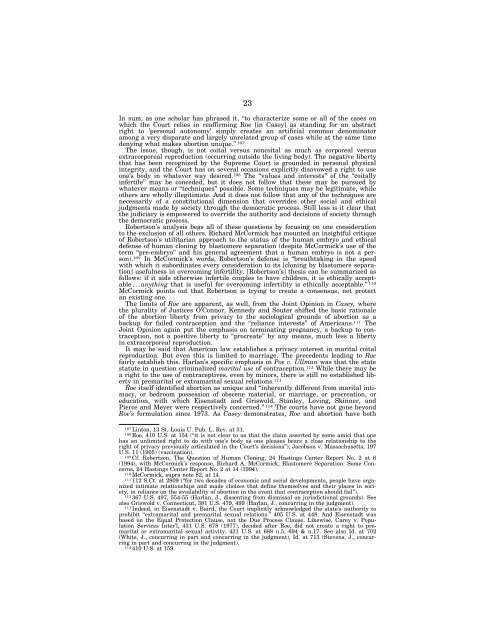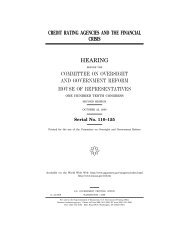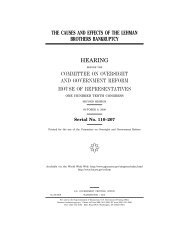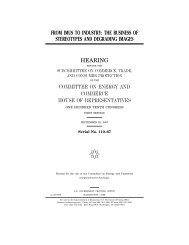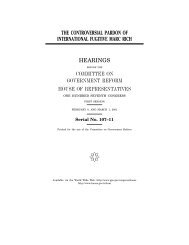22tion decision. The father of ‘‘the developing child’’ (as Casey used the phrase 98 ), eventhe woman’s husband, has no right to consent (Danforth) or even notice (Casey).Many efforts by men to intervene in and stop abortions have been summarily rejectedby the courts. 99 Men have no legal right to be involved in abortion decisionmaking.Formally, the decision is the woman’s. Roe saw the decisionmaking as betweenthe woman and her doctor only, 100 and, as the plurality stated in Casey,‘‘what is at stake is the woman’s right to make the ultimate decision.’’ 101 The pluralityin Casey went on, at great length, describing the total exclusion of the fatheror spouse from decisionmaking. 102 Legal commentators rejecting legal regulation ofin vitro fertilization are inclined to wax eloquent over the involvement of ‘‘couples’’in ‘‘decisions about whether and when to bear children’’ but fathers (and spouses)are strictly and absolutely excluded from the Roe framework and abortion decisionmaking. 103The limits of Roe are fairly admitted even by proponents of a broad right of noncoitalprocreation. Thus, such a familiar advocate as John Robertson states:In the United States, the right to avoid reproduction by contraception andabortion is now firmly established. Whether single or married, adult or minor,a woman has a right to terminate pregnancy up to viability 104 and both menand women have the right to obtain and use contraceptives. The right to procreate—tobear, beget and rear children—has received less explicit legal recognition...[N]ocases (with the possible exception of Skinner v. Oklahoma) turnon the recognition of such a right. However, dicta in cases ranging from Meyerv. Nebraska to Eisenstadt v. Baird clearly show a strong presumption in favorof marital decisions to found a family...What then about married couples whocannot reproduce coitally?...The values and interests that undergird the rightto coital reproduction clearly exist with the coitally infertile. Their interest inbearing, begetting or parenting offspring is as worthy of respect as that of thecoitally fertile. It follows that restrictions on noncoital reproduction by an infertilemarried couple should be subject to the same rigorous scrutiny to which restrictionson coital reproduction would be subject. 105Again, Robertson has noted the limits to Roe elsewhere, referring to ‘‘a woman’s decisionnot to conceive or bear a child.’’Even though the Court has eliminated most of the legal limitations on theright to avoid pregnancy, the freedom not to procreate is still circumscribed bya number of restrictions. One such restriction derives from the negative natureof constitutional protections, which shield individuals from state interferencewith their liberty but do not guarantee them the means to exercise thoserights. 10698 112 S.Ct. at 2817.99 See e.g., Conn v. Conn, 525 N.E.2d 612 (Ind. Ct. App), aff’d, 526 N.E.2d 958 (Ind.), cert.denied, 488 U.S. 955 (1988); Smith v. Doe, 530 N.E.2d 331 (Ind. Ct. App. 1988), cert. denied,492 U.S. 919 (1989).100 410 U.S. at 156.101 112 S.Ct. at 2821.102 112 S.Ct. at 2826-31.103 See e.g., Lori Andrews, The Legal Status of the Embryo, 32 Loyola L. Rev. 357, 359 (1986).104 This misrepresents the scope of the Roe-Casey liberty. Roe did not limit the abortion libertyto viability. Instead, with the companion decision of Doe v. Bolton, 410 U.S. 179 (1973), Roe establisheda right to a ‘‘health’’ abortion throughout pregnancy (defined as ‘‘all factors—physical,emotional, psychological, familial, and the woman’s age—relevant to the well-being of the patient.All these factors may relate to health’’). Id. at 192. Several federal courts have given sucha broad reading to the ‘‘health’’ exception after viability. See e.g., Women’s Med. Prof. Corp. v.Voinovich, 130 F.3d 187 (6th Cir. 1997), cert. denied, 118 S.Ct. 1347 (1998) (Thomas, J., dissentingfrom the denial of certiorari); American College of Obstetricians and Gynecologists v.Thornburgh, 737 F.2d 283, 298-99 (3d Cir. 1984), aff’d, 476 U.S. 747 (1986); Margaret S. v. Edwards,488 F.Supp. 181 (E.D. La. 1980); Schulte v. Douglas, 567 F.Supp. 522 (D.Neb. 1981), aff’dper curiam, sub nom. Women’s Servs., P.C. v. Douglas, 710 F.2d 465 (8th Cir. 1983). Thebreadth of this ‘‘health’’ exception after viability was not altered in the Casey decision. PlannedParenthood v. Casey, 505 U.S. 833, 846 (1992) (reaffirming ‘‘State’s power to restrict abortionafter fetal viability, if the law contains exceptions for pregnancies which endanger a woman’slife or health’’), Id. at 878 (reaffirming Roe’s holding ‘‘that subsequent to viability, theState...may...regulate, and even proscribe, abortion except where it is necessary, in appropriatemedical judgment, for the preservation of the life or health of the mother.’’), Id. at 871(‘‘when the fetus is viable, prohibitions are permitted provided the life or health of the motheris not at stake’’).105 John A. Robertson, Decisional Authority over Embryos and Control of IVF Technology, 28Jurimetrics J. 285, 290 (1988).106 Robertson, Procreative Liberty and the Control of Conception, Pregnancy, and Childbirth,69 VA L. Rev. 405, 405 n.3 (1983).VerDate 11-MAY-2000 07:46 May 24, 2001 Jkt 000000 PO 00000 Frm 00026 Fmt 6633 Sfmt 6621 71495.TXT HCOM2 PsN: HCOM2
23In sum, as one scholar has phrased it, ‘‘to characterize some or all of the cases onwhich the Court relies in reaffirming Roe [in Casey] as standing for an abstractright to ’personal autonomy’ simply creates an artificial common denominatoramong a very disparate and largely unrelated group of cases while at the same timedenying what makes abortion unique.’’ 107The issue, though, is not coital versus noncoital as much as corporeal versusextracorporeal reproduction (occurring outside the living body). The negative libertythat has been recognized by the Supreme Court is grounded in personal physicalintegrity, and the Court has on several occasions explicitly disavowed a right to useone’s body in whatever way desired. 108 The ‘‘values and interests’’ of the ‘‘coitallyinfertile’’ may be conceded, but it does not follow that these may be pursued bywhatever means or ‘‘techniques’’ possible. Some techniques may be legitimate, whileothers are wholly illegitimate. And it does not follow that any of the techniques arenecessarily of a constitutional dimension that overrides other social and ethicaljudgments made by society through the democratic process. Still less is it clear thatthe judiciary is empowered to override the authority and decisions of society throughthe democratic process.Robertson’s analysis begs all of these questions by focusing on one considerationto the exclusion of all others. Richard McCormick has mounted an insightful critiqueof Robertson’s utilitarian approach to the status of the human embryo and ethicaldefense of human cloning by blastomere separation (despite McCormick’s use of theterm ‘‘pre-embryo’’ and his general agreement that a human embryo is not a person).109 In McCormick’s words, Robertson’s defense is ‘‘breathtaking in the speedwith which it subordinates every consideration to its [cloning by blastomere separation]usefulness in overcoming infertility. [Robertson’s] thesis can be summarized asfollows: if it aids otherwise infertile couples to have children, it is ethically acceptable...anythingthat is useful for overcoming infertility is ethically acceptable.’’ 110McCormick points out that Robertson is trying to create a consensus, not protectan existing one.The limits of Roe are apparent, as well, from the Joint Opinion in Casey, wherethe plurality of Justices O’Connor, Kennedy and Souter shifted the basic rationaleof the abortion liberty from privacy to the sociological grounds of abortion as abackup for failed contraception and the ‘‘reliance interests’’ of Americans. 111 TheJoint Opinion again put the emphasis on terminating pregnancy, a backup to contraception,not a positive liberty to ‘‘procreate’’ by any means, much less a libertyin extracorporeal reproduction.It may be said that American law establishes a privacy interest in marital coitalreproduction. But even this is limited to marriage. The precedents leading to Roefairly establish this. Harlan’s specific emphasis in Poe v. Ullman was that the statestatute in question criminalized marital use of contraception. 112 While there may bea right to the use of contraceptives, even by minors, there is still no established libertyin premarital or extramarital sexual relations. 113Roe itself identified abortion as unique and ‘‘inherently different from marital intimacy,or bedroom possession of obscene material, or marriage, or procreation, oreducation, with which Eisenstadt and Griswold, Stanley, Loving, Skinner, andPierce and Meyer were respectively concerned.’’ 114 The courts have not gone beyondRoe’s formulation since 1973. As Casey demonstrates, Roe and abortion have both107 Linton, 13 St. Louis U. Pub. L. Rev. at 31.108 Roe, 410 U.S. at 154 (‘‘it is not clear to us that the claim asserted by some amici that onehas an unlimited right to do with one’s body as one pleases bears a close relationship to theright of privacy previously articulated in the Court’s decisions’’); Jacobson v. Massachusetts, 197U.S. 11 (1905) (vaccination).109 Cf. Robertson, The Question of Human Cloning, 24 Hastings Center Report No. 2 at 6(1994), with McCormick’s response, Richard A. McCormick, Blastomere Separation: Some Concerns,24 Hastings Center Report No. 2 at 14 (1994).110 McCormick, supra note 82, at 14.111 112 S.Ct. at 2809 (‘‘for two decades of economic and social developments, people have organizedintimate relationships and made choices that define themselves and their places in society,in reliance on the availability of abortion in the event that contraception should fail’’).112 367 U.S. 497, 554-55 (Harlan, J., dissenting from dismissal on jurisdictional grounds). Seealso Griswold v. Connecticut, 381 U.S. 479, 499 (Harlan, J., concurring in the judgment).113 Indeed, in Eisenstadt v. Baird, the Court implicitly acknowledged the state’s authority toprohibit ‘‘extramarital and premarital sexual relations.’’ 405 U.S. at 448. And Eisenstadt wasbased on the Equal Protection Clause, not the Due Process Clause. Likewise, Carey v. PopulationServices Inter’l, 431 U.S. 678 (1977), decided after Roe, did not create a right to premaritalor extramarital sexual activity. 431 U.S. at 688 n.5, 694 & n.17. See also Id. at 702(White, J., concurring in part and concurring in the judgment), Id. at 713 (Stevens, J., concurringin part and concurring in the judgment).114 410 U.S. at 159.VerDate 11-MAY-2000 07:46 May 24, 2001 Jkt 000000 PO 00000 Frm 00027 Fmt 6633 Sfmt 6621 71495.TXT HCOM2 PsN: HCOM2
- Page 1 and 2: ISSUES RAISED BY HUMAN CLONING RESE
- Page 3 and 4: C O N T E N T SPageTestimony of:Boi
- Page 5 and 6: ISSUES RAISED BY HUMAN CLONINGRESEA
- Page 7 and 8: 3Would human cloning lessen the wor
- Page 9 and 10: 5Chairman TAUZIN. Thank you, Mr. Ch
- Page 11 and 12: 7and cell therapy and beta cell dev
- Page 13: 9safety and the moral condition of
- Page 17 and 18: 13seen in the common phrase, being
- Page 20 and 21: 16a want of capacity to live were a
- Page 22 and 23: 18eight to ten weeks gestation as a
- Page 24 and 25: 20Washington v. Glucksberg ignores
- Page 28 and 29: 24been treated as ‘‘sui generis
- Page 30 and 31: 26Perhaps the three most compelling
- Page 32 and 33: 28are their genes. We know that chi
- Page 34 and 35: 30ago, Nobel Prize-winning biologis
- Page 36 and 37: 32Mr. JOHN. Thank you, Mr. Chairman
- Page 38 and 39: 34Mr. GREENWOOD. The Chair thanks t
- Page 40 and 41: 36to turn undifferentiated human pl
- Page 42 and 43: 38these issues have not yet even be
- Page 44 and 45: 40really have a clue what those gen
- Page 46 and 47: 42mately 150 days of gestation and
- Page 48 and 49: 44Hill JR, Winger QA, Long CR, Loon
- Page 50 and 51: 46clones will not change a bit by t
- Page 52 and 53: 48technologies, we’re able today
- Page 54 and 55: 50from the testes of infertile men
- Page 56 and 57: 52not be taken away from people, be
- Page 58 and 59: 54a result of this declaration, I w
- Page 60 and 61: 56Too much pressure, too many expec
- Page 62 and 63: 58requires some level of scientific
- Page 64 and 65: 60an abnormal person. So I think it
- Page 66 and 67: 62to the world, back to this earthl
- Page 68 and 69: 64which is not true for cow which i
- Page 70 and 71: 66Ms. BOISSELIER. University of Hou
- Page 72 and 73: 68Ms. BOISSELIER. Soon.Ms. DEGETTE.
- Page 74 and 75: 70Mr. ZAVOS. No, no. We believe tha
- Page 76 and 77:
72cloning process. And without that
- Page 78 and 79:
74have to look at the structure of
- Page 80 and 81:
76Mr. LARGENT. So the answer is no,
- Page 82 and 83:
78that very much and you are excuse
- Page 84 and 85:
80that people have incorrectly stat
- Page 86 and 87:
82My name is Dr. Thomas Murray. I
- Page 88 and 89:
84human subjects against irresponsi
- Page 90 and 91:
86might be born as a result of this
- Page 92 and 93:
88ever, it is not unusual for the g
- Page 94 and 95:
90Mr. DEUTSCH. Because there really
- Page 96 and 97:
92Ms. ZOON. When we found out about
- Page 98 and 99:
94Mr. GREENWOOD. The time of the ge
- Page 100 and 101:
96Be that as it may I think there a
- Page 102 and 103:
98There has been progress in the cl
- Page 104 and 105:
100may find that it is a terrible e
- Page 106 and 107:
102entists tried to get this ban ov
- Page 108 and 109:
104lies in our hands. And we face a
- Page 110 and 111:
106clude Ireland, Israel, Italy, Fr
- Page 112 and 113:
108strict IVF and similar high-tech
- Page 114 and 115:
110while ‘‘clone then love’
- Page 116 and 117:
112What Cloning Is Not—The ‘‘
- Page 118 and 119:
114And the largest group of people
- Page 120 and 121:
116The last piece to the legal puzz
- Page 122 and 123:
118cloning law on both scientific f
- Page 124 and 125:
120mendous potential human safety r
- Page 126 and 127:
122age him to do this research and
- Page 128 and 129:
124I realize there have been calls
- Page 130 and 131:
126‘‘from which I have no assoc
- Page 132 and 133:
128TO HAVE CHILDREN,’’ I ask th
- Page 134 and 135:
130of ourselves as humans in our pr
- Page 136 and 137:
132Our Genetic Science Task Force c
- Page 138 and 139:
134But this was also true in occide
- Page 140 and 141:
136So we utilized good science to d
- Page 142 and 143:
138egg and so on. What you’re tal
- Page 144 and 145:
140Mr. DEUTSCH. I think that’s ac
- Page 146 and 147:
142and dad? We all did that when we
- Page 148 and 149:
144Food, Drug and Cosmetics Act or
- Page 150 and 151:
146Mister Chairman, the embryo may
- Page 152 and 153:
148The current low rate of cloning
- Page 154 and 155:
150TIME magazine’s pictorial, ‘
- Page 156 and 157:
152John A. Robertson, University of


